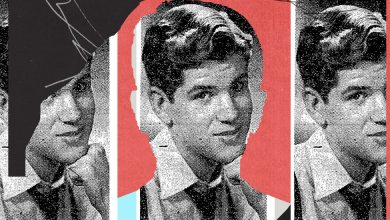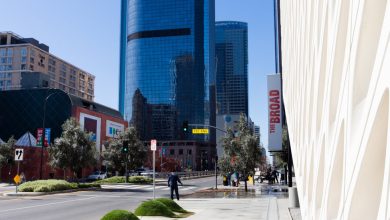Review: Reimagined Gibney Company Makes a Long-Winded Debut

Just before the pandemic, in January 2020, Gina Gibney, a choreographer and entrepreneur, announced that she was reinventing her dance company. Why, she wondered at the time, did New York City not have a company on the same level as a Nederlands Dans Theater or a Ballet BC?
To be honest, that never really struck me as a problem. The aesthetic direction of those groups — choreography with slippery swirls and hollow gestures — wasn’t something I pined for. But Gibney has accomplished what she set out to do: She has established a contemporary repertory company of 12 dancers that made its debut at the Joyce Theater exactly when she planned for it to happen: now.
On Tuesday, the Gibney Company presented three premieres, by Sonya Tayeh, the Tony Award-winning choreographer of “Moulin Rouge! The Musical”; Alan Lucien Oyen, the Norwegian writer, director and choreographer; and Rena Butler, Gibney’s choreographic associate who also dances. (Gibney is the company’s artistic director, founder and chief executive; Nigel Campbell and Amy Miller are the company directors.)
If not quite an empire, Gibney Company is an enterprise. The dancers are referred to as artistic associates and, in addition to performing, they also contribute as community activists in the dance field.
So where does the art come in? Gibney’s debut program was overstuffed and at times puerile; after more than two hours of watching hyper-mobile performers bend and flex, I was more depleted than enlightened. Much of the choreography seemed to be generated by similar improvisation exercises. Butler’s “Lusus Naturae,” a trio exploring King Kong from the angle of decolonizing the self, was the most illuminating; at times, it could have been more subtle, but at least it was concise.
As Alexander Anderson, Jesse Obremski and Jake Tribus morphed and melted from sculptural lifts into deep, swaying squats, they also crumbled and rose to climb over one another as Earthgang’s “Missed Calls” played. (Darryl J. Hoffman did the sound design.) Eventually, pulling apart, they moved in sync finding a groove — and exuding an underlying vulnerability — as the lyrics rolled by: “And I suggest you trace your scars if you get lost, my dears.”
At one point, the dancers even joined in — urgently reciting lyrics in tandem from the lip of the stage. Did I sense, in moments, the work of Kyle Abraham, with whom Butler once danced and who was her choreographic adviser on this piece? Sure. But I could also feel her touch in the way softness revealed strength. It was as if they were extinguishing “kong” to take ownership of “king.”
“Lusus Naturae” was book-ended by two longer, more ponderous works: Oyen’s “The Game Is Rigged” and Tayeh’s “Oh Courage!” set to an original composition played live by the indie-folk duo, the Bengsons. While “Oh Courage!” had a raucous side, courtesy of the music, “The Game” was more internal; the cast members spoke (or mumbled) their anguish. Near the start, Leal Zielinska — at first smiling and inserting little giggles — said, “Where is?” and “Where is here?” She slapped the air around her head, as if she were under a mosquito attack, adding, “The game is rigged.”
It’s the game, it seems, of life. While these artistic associates were skilled at expressing the fervor of their minds with extreme torque and spasms — here and in “Courage!,” it was as though they were constantly being electrocuted — they were less credible when reciting text while moving.
The dialogue amounted to little more than journal entries. “The Game,” emotionally underwhelming and spiraling forward with seemingly no end in sight — it lasted around 45 minutes — felt dated, like a dance-theater experiment from the 1990s, seen through the lens of the pandemic and self-isolation. Its biggest mystery was why the women were continually flung around like objects.
If “The Game” was about inner turmoil, “Oh Courage!” was about finding resilience. “I’m coming to you!” shouted Abigail Bengson, one half of the music duo with her husband, Shaun Bengson. “Palm open!”
During what seemed like an evocation — it was all a little cultish — Butler, arching back and sinking to the floor in deep pliés, made her way to a pile of speakers placed in between the musicians. Standing on them, she waved and rippled her arms. The set, by Rachel Hauck, who designed “Hadestown,” took up a good portion of the stage, leaving less room for dancing than the creation of tableaux in which the performers, arranging themselves around the musicians, stared meaningfully into the distance.
Directives from Abigail persisted: “Jump the life back into you!”
As the dance continued, the performers swept back and forth across the stage in unison or rocked in place as if they were about to pounce; their bodies were in a continual stage of wilting and blooming as the singers drove them on, encouraging them to illustrate their courage, their daring.
“Shake these bones!” Abigail urged, later becoming preacher-feverish in her delivery with the chant, “Hope is an action!”
The dancers gathered in a tight circle, jumping and reaching toward some unattainable object. Finally, the music stopped, and they parted ways, taking up as much space as they could while lifting off the floor in hops propelled by a leg that swung forward and back. It was a lesson in fortitude — all around.
Gibney Company
Through Sunday at the Joyce Theater, Manhattan; joyce.org.





